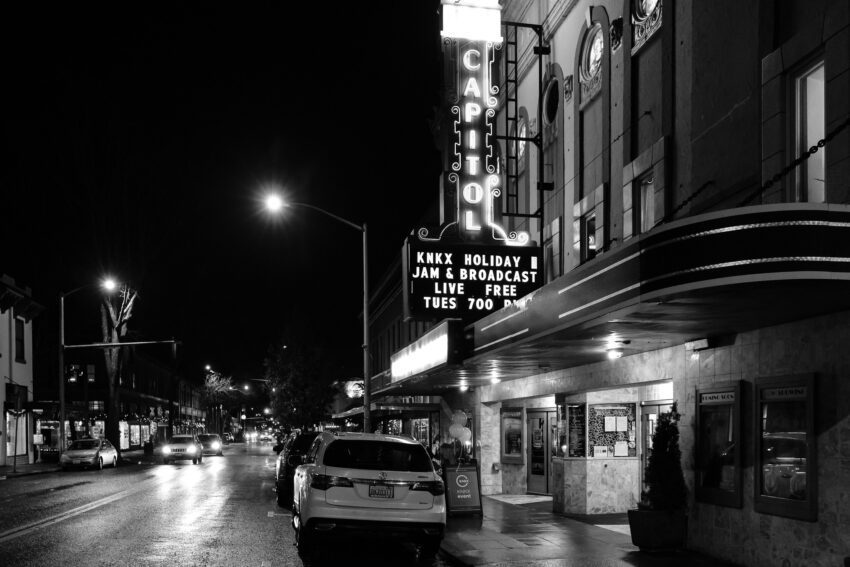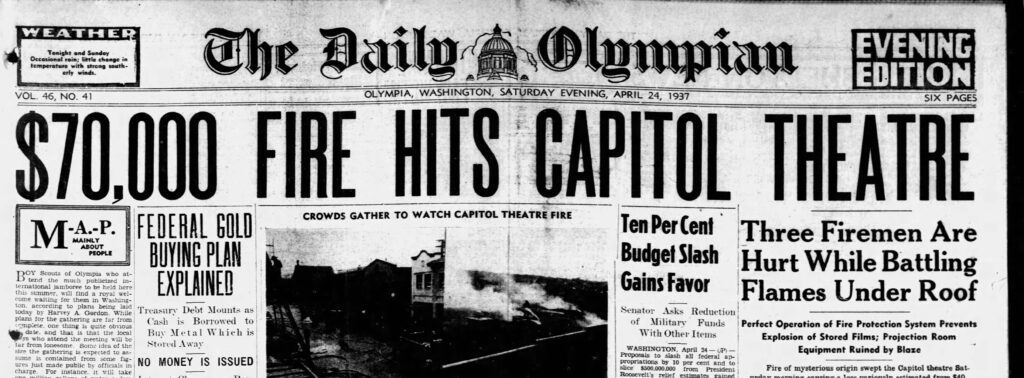
The Haunting of the Capitol Theater in Olympia
Olympia’s Capitol Theater is an iconic landmark. Built in 1924, it has stood the test of time through fires, financial struggles, earthquakes, and decades of history. But beneath its charming vintage facade lies a past filled with tragedy and hardship—a past that some say has left more than just memories behind.
The History of the Capitol Theater

The Capitol Theater first opened its doors in 1924, envisioned as a grand entertainment venue by the Evergreen State Amusement Corporation. It quickly became a hub for Olympia’s cultural scene, offering films, vaudeville acts, and community events. However, the theater’s glamorous start was soon shadowed by a series of unfortunate events.
The Fire of 1937
On April 24, 1937, a fire broke out inside the Capitol Theater. It’s unclear how the fire started, but it quickly spread, damaging much of the interior. Thankfully, the fire occurred during the early morning hours, and no one was injured. However, the fire left the building gutted, with charred seats and smoke-stained walls. The theater was forced to close for several months, and the cost of repairs took a heavy toll on its finances.
The fire was a turning point in the theater’s history, with some saying that it marked the beginning of its haunted reputation. After its reopening in August 1937, rumors began circulating about strange occurrences within the walls—shadows moving in the dark, flickering lights, and the inexplicable sound of footsteps.
Financial Struggles and Decline
The Capitol Theater’s troubles didn’t end with the fire. The late 1930s and 1940s were difficult years financially. The Great Depression had a lingering effect on local businesses, and the theater struggled to draw in crowds as people had less money to spend on entertainment. It changed ownership multiple times, with each new proprietor attempting to restore it to its former glory, but the financial challenges persisted.
One notable figure during this period was Henry Caldwell, who purchased the theater in 1942. Caldwell was determined to breathe new life into the venue, even adding live musical performances to draw in audiences. He succeeded for a time, but ultimately, the costs were too high, and he was forced to sell. Caldwell’s efforts, however, left a lasting impact—he’s remembered as someone who fought hard for the theater’s survival.
The Earthquake of 2001
Another traumatic event in the theater’s history was the Nisqually earthquake of 2001. The 6.8 magnitude quake caused severe damage to the theater, particularly the ornate plaster ceiling, which cracked and partially collapsed. Repairs were costly, and the theater was once again at risk of closure. This earthquake left an indelible mark, with many locals believing that the shaking of the earth had stirred up more than just dust in the old building.
The theater’s resilience through these events, despite multiple near-closures, has contributed to its enduring place in Olympia’s cultural history. But the hardships and tragedies that befell the Capitol Theater may also be the reason why some believe it is haunted.
Ghosts and Legends of the Capitol Theater

The Ghostly Projectionist
One of the most famous spirits said to haunt the Capitol Theater is that of a former projectionist. Staff members have reported seeing a shadowy figure in the projection booth late at night. Frank Miller, a projectionist who worked at the theater in the 1950s, is often named as the spirit behind these sightings. Miller was known for his dedication—some say he loved his job so much that he never truly left. Lights have been known to flicker on and off, and the projector has been seen operating on its own, as if Miller is still at work, ensuring the show goes on.
Please note: There is no proof available that the spirit really is Frank Miller.
Phantom Footsteps and Cold Spots
The balcony area is another hotspot for ghostly activity. Staff and visitors alike have reported hearing footsteps echoing through the empty rows of seats. These footsteps are often accompanied by cold spots—sudden drops in temperature that leave people with a sense of unease. Some believe these sounds are linked to the fire of 1937, suggesting that the spirits of those who may have been involved in the theater’s reconstruction linger within its walls.
The Lady in White
The Capitol Theater is also said to be haunted by the spirit of a woman known as the Lady in White. Descriptions of her vary, but she is often seen wearing old-fashioned clothing, her face obscured by a veil. Witnesses have spotted her in the aisles and on the stage, sometimes sitting quietly as if watching a performance. One legend claims she was a patron who died in the theater under mysterious circumstances, though no official records confirm this. Despite her spectral presence, those who have seen her describe her as peaceful, if unsettling.
Mysterious Events Backstage
Backstage, performers have reported strange happenings as well. Props have moved on their own, and doors open and close without explanation. The basement, in particular, has an eerie reputation. Some say they feel as though they’re being watched, and others claim to have seen fleeting shadows darting out of the corners of their eyes. The backstage area is often avoided by staff after dark, and some performers even refuse to enter alone.
Why Theaters Become Haunted

Theaters have a long history of being associated with ghost stories, even when no one has died within their walls. Why is that? The answer lies in the unique energy that theaters hold. The emotional atmosphere of a theater, with its history of passionate performances, dramatic scenes, laughter, and applause, creates a charged environment that seems to invite ghostly phenomena. The intense emotions experienced by both performers and audiences can leave behind an imprint—a kind of residual energy that lingers long after the curtain falls.
Theaters are places of heightened emotion. Actors pour themselves into their roles, and audiences get swept up in the stories unfolding before them. This emotional intensity, repeated night after night, may leave traces that contribute to the feeling of a haunting. Additionally, theaters are often old buildings, with many having undergone multiple renovations, financial struggles, or other traumatic events. All of these factors can combine to create an environment that feels ripe for paranormal activity.
Another contributing factor is the tradition and superstition that has long been part of theater culture. Many theaters have rituals meant to ward off bad luck, like the well-known tradition of saying “break a leg” instead of “good luck.” These superstitions, along with the dim lighting, labyrinthine backstage areas, and the sense of history, all contribute to the eerie atmosphere of theaters, making them seem like natural homes for spirits.
The Legacy of the Capitol Theater

The Capitol Theater is more than just a venue—it’s a living part of Olympia’s history. Its stories, both tragic and haunting, have shaped its character. From Henry Caldwell’s tireless efforts to keep the theater alive, to Frank Miller’s enduring dedication, the people who have touched the Capitol Theater have left their mark—some in ways that seem to defy time and death.
The ghosts of the Capitol Theater may never reveal themselves fully, but their presence adds an extra layer of mystery to this historic building. Whether you believe in spirits or simply enjoy a good story, the Capitol Theater remains a place where the past feels close—where the echoes of history can still be heard, and perhaps even seen, if you’re paying attention.
Discover more from Ghostly Activities
Subscribe to get the latest posts sent to your email.
